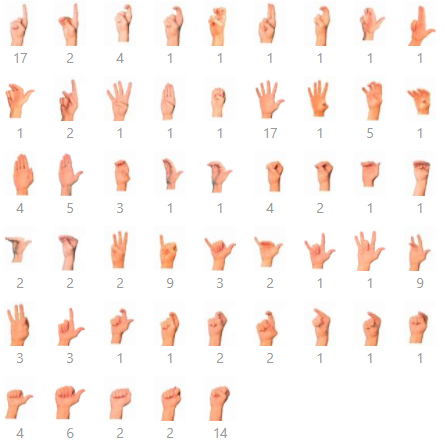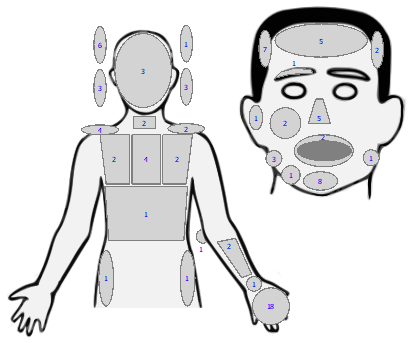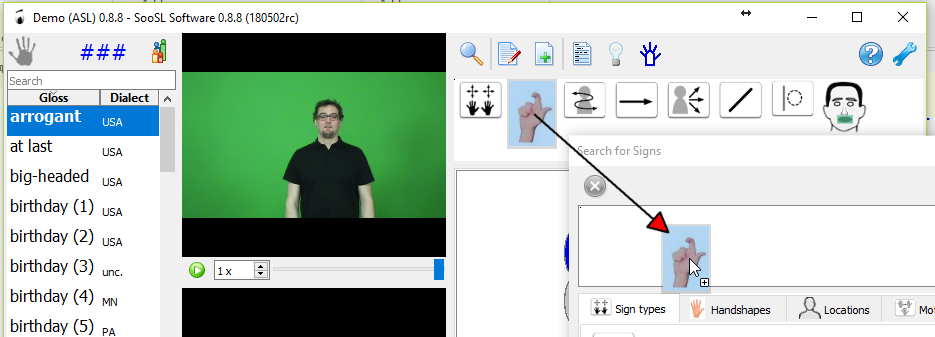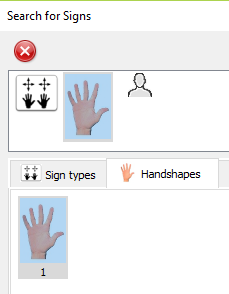Here is one of SooSL's best features: you can search for a sign by handshape, location, motion, and other characteristics. All these characteristics are called parameters.
The sections below explain how to use parameters to search for signs. First, open the search dialog, then choose one or more parameters that match the sign you are looking for.
To search by parameter (handshape, location, motion, etc.), first click the ![]() magnifying glass icon in the toolbar. You will see a search dialog. It looks a little different in SooSL Web and SooSL Desktop.
magnifying glass icon in the toolbar. You will see a search dialog. It looks a little different in SooSL Web and SooSL Desktop.
|
SooSL Web |
|
SooSL Desktop |
|
|
|
|
Near the top of this search dialog you will see icons for the 5 kinds of parameters. Click the links below to learn about each kind.
In the search dialog, click one of the five kinds of parameters. Underneath, you will see all the different parameters of that kind that are used in the dictionary. The number below each icon tells you how many signs use that parameter.
For example, if you click ![]() handshapes, you might see:
handshapes, you might see:

If the sign you are looking for has a handshape that isn't in the list, try using the closest handshape. Or, look for the sign using its other parameters.
If you click ![]() locations, you might see:
locations, you might see:

(SooSL Web does not display numbers on the body map. Instead, to see numbers, click the ![]() eye. You will see full descriptions, and the numbers are with the descriptions.)
eye. You will see full descriptions, and the numbers are with the descriptions.)
The next step is to choose which parameter(s) you want to search with. Think about the sign you are looking for and how you make it.
It usually works best to start searching by handshape and location. Add other kinds of parameters if you need them.
The numbers tell you how many signs use each parameter. If you choose that parameter, then the gloss list will get shorter; it will have only that many signs. If you want to narrow your search quickly, choose a parameter that has a small number. If you want to narrow your search more slowly, choose a higher number. What you want to do is gradually shorten the gloss list until you can find the sign you want.
Here's how you can choose a parameter.
|
Web |
Desktop |
|
There are two ways to choose a parameter:
|
The parameter you choose will appear at the top of the gloss list (W) or the top of the search dialog (D). For example, if you click the Handshapes tab and then choose the  5 handshape you will see something like this:
5 handshape you will see something like this:
|
Web |
Desktop |
|
First click the
then you will see
|
|
The gloss list now has fewer signs in it. It only lists signs that use the  5 handshape. You can click each gloss to see its video. (In SooSL Desktop, you might need to move the search dialog out of the way.) The search dialog also changes; it only shows the parameters that are used by the remaining signs. The numbers show how many of the remaining signs use each parameter.
5 handshape. You can click each gloss to see its video. (In SooSL Desktop, you might need to move the search dialog out of the way.) The search dialog also changes; it only shows the parameters that are used by the remaining signs. The numbers show how many of the remaining signs use each parameter.
However, the gloss list may still be quite long. The sign we want is somewhere in the list, but it is still hard to find. In that case, we add another parameter to the search to make the list shorter. Maybe you searched first by handshape; try adding a location. Go back to the search dialog and choose the parameter you want. Add as many parameters as you need, until the gloss list gets short enough that you find the sign.
In our example, you might choose the lower torso from the Locations tab:
|
Web |
Desktop |
|
First click the lower torso
then you will see
|
|
Now the gloss list is even shorter—just three glosses, all for the same sign. Hopefully, that's the sign you want. Play the video to check.
If you don't find the sign you want, try searching for it another way. First, remove one or more of the parameters from the search dialog. SooSL Desktop has several ways to do this; SooSL Web is simpler.
|
Web |
Desktop |
|
|
Then try searching with different parameters for the sign you want. For example, you might try sign type or one of the motion parameters. If there is a special facial expression or other body movement that always occurs with the sign, try the face/head/body parameters.
Of course, the sign might not be in the dictionary at all. No dictionary includes every sign in a language. If you can't find a sign, you might want to contact the people who made the dictionary and suggest they add it.
You can choose each parameter only once. For example, even if both hands use the  handshape, we only choose it once when we are searching. If you want to look only for two-handed signs, add one of the two-handed parameters from sign types:
handshape, we only choose it once when we are searching. If you want to look only for two-handed signs, add one of the two-handed parameters from sign types: ![]() ,
, ![]() or
or ![]() .
.
In the list of parameters that you've chosen, the icons are in a fixed order. For example, you might choose two different handshapes, because both are used in a sign. You might find the icons in the search area are not in the same order as in the sign. That's OK. The important thing is that they are included in the list somewhere, that's all you need to find the sign.
SooSL Desktop has some special features for search:


Created with the Personal Edition of HelpNDoc: Why Microsoft Word Isn't Cut Out for Documentation: The Benefits of a Help Authoring Tool